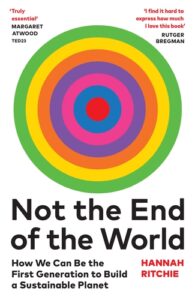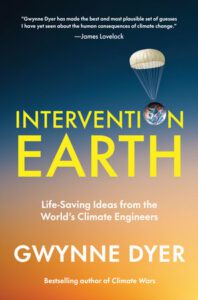Brief Book Reviews
by Ross Thrasher
As an antidote to the doomscrolling about climate change that permeates the media these days, here is a sampling of four brand-new 2024 nonfiction titles that offer a more hopeful perspective.
H Is for Hope: Climate Change from A to Z
by Elizabeth Kolbert (Ten Speed Press)
The author is a well-known environmental writer for New Yorker magazine. This attractively illustrated volume provides just a couple of pages of text for each letter of the alphabet, so it’s a quick read but packed with interesting tidbits. A is for Arrhenius, the Swedish physicist who developed a climate model a century ago that identified human-produced carbon dioxide as the prime warming agent. Z for Zero describes the Colorado River drought that has reduced the massive Lake Mead reservoir to critical levels. Perhaps “Zero Hour” would have been a better heading! Sections like E, Electrify Everything and G, Green Concrete examines one of the promising innovations in the battle against global warming, while others like C, Capitalism and Q, Quagmire put forward sobering analyses of the economic and political obstacles impeding climate-levelling efforts. H Is for Hope doesn’t sugar-coat the difficulties we face, but Kolbert has mapped out some pathways to progress.
Not the End of the World: How We Can Be the First Generation to Build a Sustainable Planet
by Hannah Ritchie (Little Brown Spark)
“Optimism is seeing challenges as opportunities to make progress” says Dr. Ritchie, an Oxford researcher and the editor of Our World in Data. She devotes a chapter to each of seven current challenges related to climate change, debunking the popular prophecies of doom, offering counter-intuitive evidence and suggesting constructive, but sometimes controversial solutions. Examples: Air and water pollution are declining as we decarbonize and exploit better waste management technologies. Nuclear energy is a very clean and safe alternative to fossil fuels. Carbon pricing is an effective mechanism to encourage the transition to renewables. The largest driver of global deforestation is not lumbering or crops for humans but cattle-raising (i.e. grazing land and animal feed), so eat less beef and save a tree. “The world cannot go organic: too many of us rely on fertilizers to survive.” The book is replete with statistics and graphs to bolster Ritchie’s claims. She also mentions Kurzgesagt, a cool graphic site on YouTube. Not the End of the World is informative, thought-provoking … and optimistic!
Escaping Nature: How to Survive Global Climate Change
by Orrin H. Pilkey et al. (Duke University Press)
Focusing on adaptation, i.e. “coping with the effects of climate change” rather than mitigation, which addresses the causes, this volume is segmented into five sections — Earth, Air, Fire, Water and Space. Each section contains a summary of the historical/scientific record, the current situation and probable future outcomes. It’s a frightening forecast in every category, of course, but the authors conclude all five sections with a practical list of “What To Do” adaptive measures. The text is enhanced throughout with colourful photos, maps and charts. The back of the book includes examples of new ideas and developments; a list of what you should have in your “bug-out [evacuation] bag”; and a comprehensive bibliography. Escaping Nature is a handy climate-adaptation reference work for every citizen, and a well-researched compendium of information on our overheating planet.
Intervention Earth: Life-Saving Ideas from the World’s Climate Engineers
by Gwynne Dyer (Random House Canada)
Canadian journalist Dyer has interviewed 60 leading climate scientists in search of the most promising mitigation strategies. Their consensus calculation is that on current trend lines, the Earth’s “carbon budget” will be used up by 2035. After that any additional CO2 in the atmosphere will trigger tipping points that will result in Hothouse Earth, unmanageable runaway consequences threatening the collapse of civilization. So we have about a decade to put a lid on global warming. Dyer catalogues and evaluates the variety of climate-management techniques that are either already underway or could be deployed in this life-saving campaign. For instance, how effective are carbon capture and storage (CCS) and other CO2-removal strategies? Should we be seriously considering the more extreme concept of Solar Radiation Management? Intervention Earth presents some powerful arguments, buttressed by expert research. It’s a fascinating read, and as the author says at the end: “The exam is not over. We’re not doomed yet.”
See what else we have in the GTEC Blog! Read articles on climate change, sustainability, education, and more!
Adaptation is absolutely key to surviving the impacts of climate change. This is why GTEC has developed the Community-based Collaborative Model and implemented the Building Climate Change Resilience program to educate, activate and support communities in the face of climate change.





